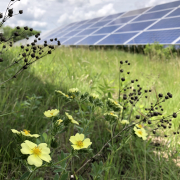Resources for Land Access
By Victorian Smart, NCAT Energy Program Assistant
If you dream of owning land someday, you’ve probably also experienced apprehension about the process of finding and buying the land. This is the reality of land acquisition – it is financially and mentally challenging to start the process. A survey conducted by the Young Farmer’s Coalition found that access to land is the greatest challenge for young farmers and ranchers. Land ownership, particularly for agriculture, can also be complicated by competition with development companies.
In recent years, many Americans’ desire to shift from urban living to living on their own land has increased. In the past two years of the COVID-19 pandemic, that desire has become stronger, as stay-at-home orders and job changes brought new perspective to people’s lives. Additionally, land seekers want to participate in affordable, sustainable agriculture and renewable energy options as awareness for local solutions for climate change mitigation and adaptability grows.
Land Links
A LandLink or FarmLink site is a useful tool if you are wishing to find land or if you are a landowner wishing to list land. LandLink tools are available for nearly all U.S. states. When you visit your state’s website, you will create a profile as a Land Seeker or a Land Owner. At that point you may make listings, search for available property in your area, connect with people, and access other resources. All LandLinks operate under the same goal—to help beginning farmers access affordable land, help established farmers stay competitive and expand, and help landowners find the right person to manage their land and one day transfer their land to. The Farmland Information Center of American Farmland Trust (AFT) has an extensive list of all state LandLink programs.
Tips For Getting Started
If you are ready to begin the process of finding and buying land but are unsure where to start, AFT breaks it down into four steps:
- Assess Your Readiness – Ask yourself about both your personal goals and business goals. Personal goals include goals for the whole family, your income, and a work-life balance. Consider business goals, like what you specifically want to do with your land, marketability for what you have to offer that comes from your land, and desire to expand in the future. AFT’s Farmland Information Center has several worksheets to help you make these assessments.
- Think About your Financial Position – Consider your current financial position and your future earning potential. Make a record of your assets, debts, income, and expenses. Make projections of what your business could earn, if you need a second income, and if this can pay off any loans you might have. Check out AFT’s Financial Readiness Assessment to get started.
- Explore Land Access Options – Besides inheritance or receiving a gift, buying and leasing are the primary ways to access land. Several options are available for leasing, including Cash Lease, Crop Share, and a Long-Term Lease. Buying options include Lease with Option to Buy, Fee Title Purchase with Seller Financing, and Fee Title Purchase with Agricultural Conservation Easement. A conservation easement prevents development rights on the land and is used if landowners wish to keep the land as agriculture production in perpetuity. See the National Center for Appropriate Technology’s detailed description of each of these access options, along with AFT’s toolkit on leasing and toolkit on buying.
- Connect with Ag Service Providers – AFT highlights the importance of connecting with agriculture service providers throughout the land-seeking process. Finding land can be time-consuming and costly, but you can find much support from networks like AFT’s Farmland Information Center, Cooperative Extension Offices at Land Grant Universities, and Farm Link programs.
Other Helpful Resources
Since energy is essential for agriculture production, more is being done to make energy generation and consumption more sustainable for farms. Also, financial opportunities for implementing renewable-energy projects are becoming more available as states pursue net-zero goals. The U.S. Department of Agriculture offers a grant for agriculture producers and small businesses. There are also many state and local tax incentives available for landowners and land managers pursuing renewable energy. When looking for land, consider your renewable energy goals and what is required to get the infrastructure on your land. For example, if your goal is to install photovoltaic arrays for solar energy production, you’ll need to assess your land’s topography, flood zones, existing houses or buildings, and amount of sunlight you have across your property. Consult U.S. DOE’s Farmers Guide to Going Solar for more information about installing solar energy on your property. Geothermal systems for farm buildings and greenhouses are another renewable energy option for maintaining consistent temperatures throughout hot and cold seasons. Some systems are ground-sourced and require underground installation, so careful consideration of your operation’s needs and land features is important before excavation.
The resources provided here include more detail for the land seeking and buying process, such as business planning, writing a good lease, land policy, and renewable energy ownership structures. If you have any questions, comments, or would like us to connect you with someone in your area, please reach out to us at agrisolar@ncat.org.


 NREL, Dennis Schroeder
NREL, Dennis Schroeder